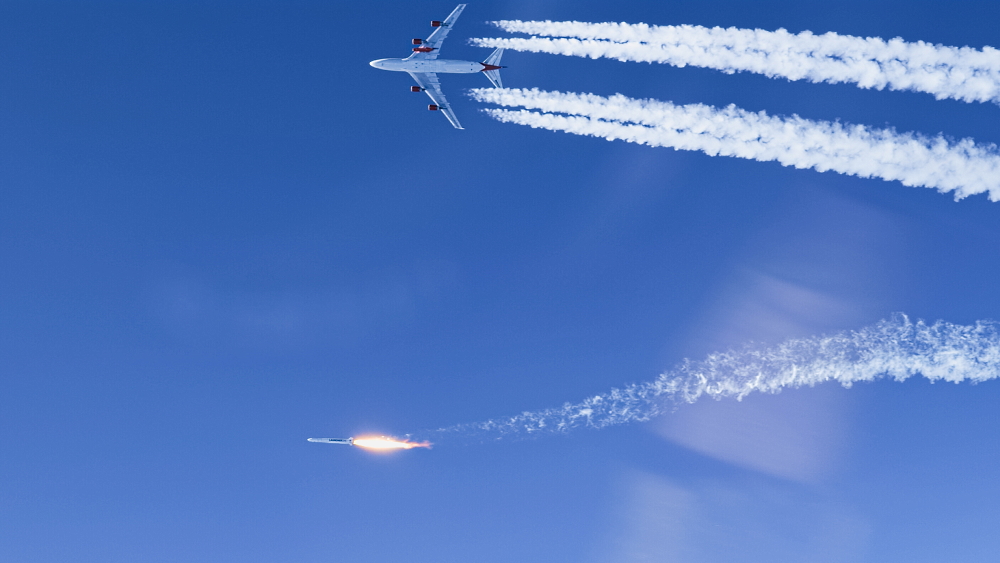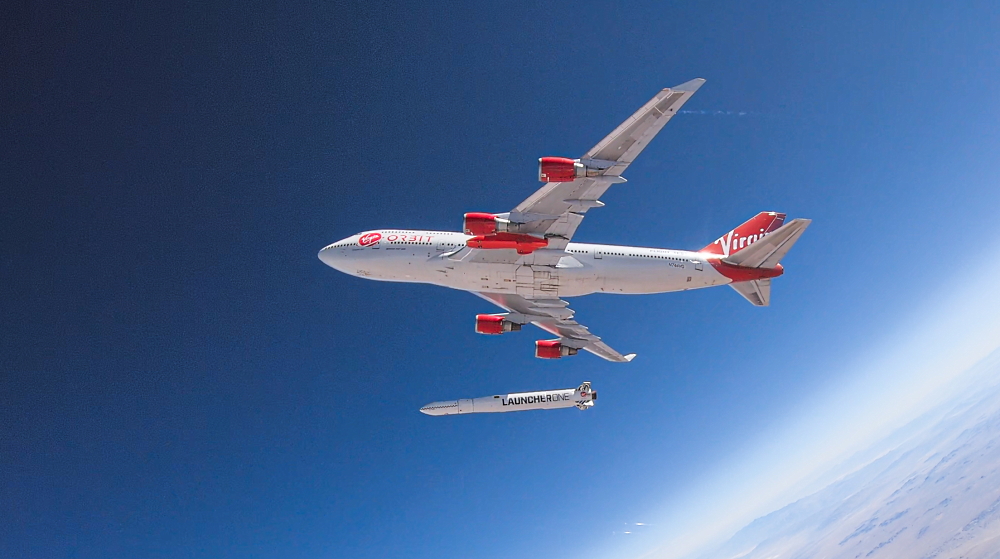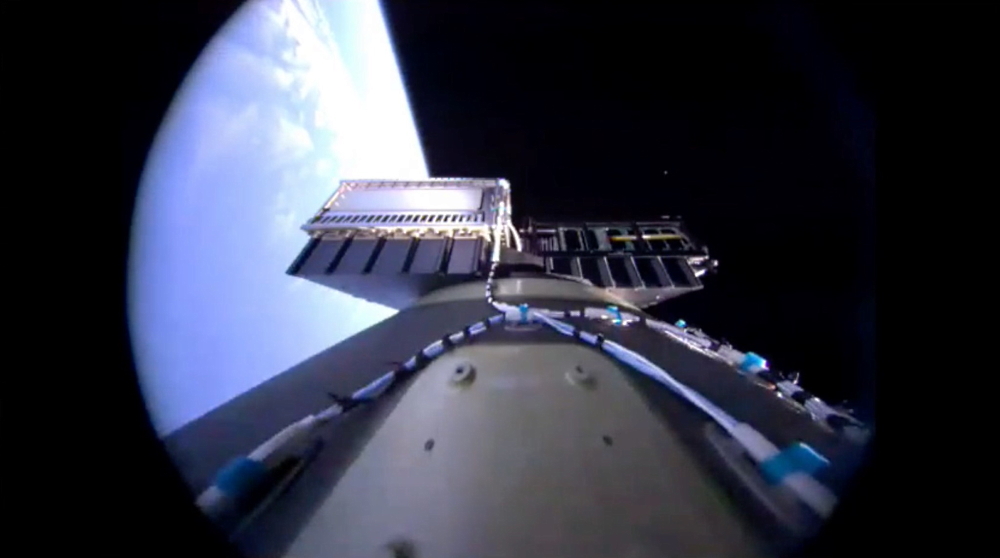
Virgin Orbit Photos
Complex

Virgin Orbit Photos
LauncherOne consists of a rocket of the same name and a Space Girl carrier aircraft. The rocket is 21 meters long, weighs in the region of 30 tons, consists of two liquid stages and can put up to 500 kg into orbit. Engines of both stages run on kerosene-liquid oxygen fuel pair. The first stage engine, NewtonThree (N3), develops a thrust of 33 tons, the second stage engine, NewtonFour (N4) - 2.2 tons. The carrier is a modified Boeing 747, which was built in 2001 and has long been operated by Virgin Atlantic, a member of the Virgin conglomerate, together with Virgin Orbit and Virgin Galactic (a suborbital spaceplane SpaceShipTwo), on the London-New York line, where it transported over 2.5 million passengers. For transporting and launching a rocket at the root of the left wing in place of a standard pylon for transporting engines,which the usual seven hundred and forty-seventh has, installed a launch guide.
A typical launch sequence consists of the following stages: An aircraft with a rocket takes off about an hour before launch, gains an altitude of 10 km and enters the area above the sea, where it begins to describe a rectangle, one of the sides of which coincides with the launch azimuth, gaining readiness. For greater safety, immediately after the missile is dropped, the plane goes up. In the third second of the rocket's free fall, the ignition of the first stage is turned on, and in the fifth second, its engine is turned on. The engine runs for three minutes and, having reduced the thrust at one hundred and eighty seconds, turns off at one hundred and eighty-seventh. After the separation of the first stage at one hundred and ninety seconds, the second stage engine starts at one hundred and ninety-fourth. The nose fairing is reset at two hundred and nineteenth seconds. At the five hundred and fiftieth second, the second stage engine turns off,and the stage begins to slowly rotate, preparing for the apogee maneuver. After 49 minutes, the stage turns on the attitude thrusters to get the correct position in space. At the end of the fifty-fifth minute of flight, the second stage engine is turned on a second time to run for just under five seconds. Then, at the end of the fifty-seventh minute, the payload begins to separate.
Development of the system began in 2007. Initially, WhiteKnightTwo, which is used with the SpaceShipTwo spaceplane, was considered as a carrier, but the desire to increase the rocket's payload made it too heavy for the White Knight. So in the project in 2015, a modified "seven hundred and forty-seventh" appeared. They wanted to launch the first launch in 2017, but due to the usual postponement in such cases, the first attempt took place in the spring of 2020.
May accident

Virgin Orbit video
First launch, May 25, 2020, failed. On the GIF, with some diligence, you can see that at the ninth second, the first stage engine simply shut off. The reason was found quickly - the high pressure pipeline that supplied the oxidizer to the engine collapsed. The solution to the problem also turned out to be simple - the problem area was made more durable. Despite the setback, the developers were able to obtain data from the very important initial stages of separation, stabilization, engine start and nose-up turn, which confirmed the correctness of calculations and preliminary tests.
Start January 17

Virgin Orbit video
The second attempt, January 17, 2021, was successful. Ten cubesats of NASA's ELaNa educational program were safely in orbit, and LauncherOne became the first air-launched rocket with only liquid propellant rocket engines. The satellites developed within the walls of universities are designed to solve a variety of tasks from testing the possibility of capturing space debris with an airgel and testing a braking device for fast deorbiting to the ability to control a satellite by anyone using a smartphone app and shooting 360 ° panoramas.

Photo from the onboard camera of the rocket
Conclusion
At least three launches of LauncherOne are planned for 2021. Let's see what performance Virgin Orbit can provide. The Pegasus air launch vehicle has had 44 launches since 1990, of which 39 were successful. But you need to understand that the concept of kubsat appeared only in 1999, and they spread at least a decade later. In general, despite the different engines, LauncherOne turned out to be in many ways similar to the Pegasus - both converted serial passenger aircraft are used as carriers - Pegasus is dropped from the L-1011 with the personal name Stargazer. The carrying capacity was surprisingly close - the Pegasus had 450 kg, the LauncherOne had up to 500 kg. It is quite possible that we will not see competition between the two missiles - despite the formal absence of an announcement about the retirement of the Pegasus, the last launch took place in 2019,and new ones are not expected in the near future. Pegasus is called the first private launch vehicle, but the development company has long been taken over by the huge Northrop Grumman. Perhaps, in a historical perspective, the niche of small air launch missiles will go to smaller private companies. And in a global sense, despite the attractiveness of an air launch in that the rocket launches in thinner air and a little closer to space, without the appearance of high-altitude and high-speed aircraft carriers of serious advantages, itthat the rocket starts in thinner air and a little closer to space, without the appearance of high-altitude and high-speed aircraft carriers, itthat the rocket starts in thinner air and a little closer to space, without the appearance of high-altitude and high-speed aircraft carriers, it does not have .